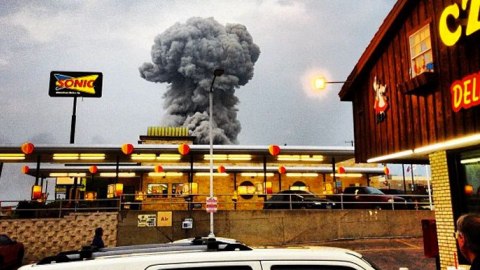
Information courtesy of the Texas Department of Insurance:
General description: Entered site a little after 10 a.m. and noticed a faint smell of fertilizer in the air. (An ATF spokeswoman says TCEQ is monitoring air quality around the clock.) About two dozen workers were seen sifting through dirt and rubble just east of the crater. We were not taken close enough to see into the crater, but assistant state fire marshal Kelly Kistner says crews are not yet investigating the crater (following the previously stated philosophy of investigating from least damage to worst damage).
Kistner: “We’re working in towards the crater. The last thing to be processed will be the crater.” — the only thing they’ve done is document its size.
We were taken to the east edge of the plant site, rather than the west edge where previous tours have gone. (The reason was because Kistner didn’t want passing trains to interfere with our tour.) We saw a few small front end loaders (known as “skid steers”) were seen carrying small amounts of dirt across flat concrete east of the crater, where the plant’s administration building used to stand. A group of about 7-10 workers in blue uniforms and light blue helmets used rakes to sift through dirt as well. A large crane was seen moving a large slab of concrete and other material around the site. Some remaining parts of the wall have also been placed back up, because authorities are hoping to reconstruct as much of the scene as they can _ something Kistner says is a key part of the investigation.
A lot of debris is piled up east of the plant area where investigators were working. The investigators are generally working 12-hour days, right now.
Stayed until about 11:25.
On delays: Chris Connealy, the state fire marshal, reiterated yesterday’s goal of a May 10 date (with the caveat that it could take longer). He described the investigation as a search for the missing puzzle piece that tells the whole story. “We’re trying to find the critical piece,” he said. They have not combed through the whole 15-acre plant site yet. The investigation has also been compared, previously and today, to an archaeological dig. (More on this below)
Step-by-step process: The 15-acre property has been broken down into seven sectors. Each of those is worked individually by teams here. Anything that seems like it could help is set aside. Teams are using shovels and rakes to sift through what they find. The “skid steers” (small front end loaders) move the rest away from the site.
Kistner would not describe all of the technologies being used because it remains an active investigation, but Champion did say an ATF specialist is working on a computer model of the fertilizer building that will allow them to run tests on hypotheses/scenarios they have in mind. That model won’t be done until the data is collected from the scene.
Size of investigation: Right now, there are about 65 to 70 ATF agents on scene and about 12 fire marshal’s investigators. ATF has sent two national response teams, according to Dallas Special Agent in Charge Robert Champion. Two NRTs are only sent to the biggest of cases (the OKC bombings are an example), he said.
General investigative approaches different agents are pursuing: Mapping the blast scene, reconstruction of scene, electrical engineering, chemical analysis, origin of blast, line of duty deaths. Off scene: Document research, interviews.
Ideas on possible causes: Nothing criminal has been ruled out. Authorities have interviewed more than 370 witnesses and received more than 200 leads, according to Kistner. I asked Kistner if he had yet had an “aha” moment as the investigation continues. He said no.
“I’ll tell you if we’ve had it, we’d be done. We’d be headed home, because the rest of us would like to be home as well.” Later: “We’re hoping the ‘aha’ moment comes when we’ve got everything put together.”
Ammonium nitrate on scene/other chemicals: Kistner said they don’t yet know exactly how much ammonium nitrate was on scene. Mapping the blast scene will help them figure that out, he said. So far, they have verbal confirmation from lab tests that all of the chemicals are fertilizer, but they don’t know what exact chemicals there are. The owner does not have a firm number right now on the amount of fertilizer on plant, Kistner said. With spring planting underway, a lot of fertilizer was going in and out. Investigators off-site are combing through records to figure out how much fertilizer would have been on site.
“We know there’s ammonium nitrate. Everybody in the world knows we got ammonium nitrate. Beyond that, I don’t know the exact names of all the other chemicals that have been brought in.” – Kistner
“This is planting season. This is fertilizing season. This is a busy, busy time for this facility right here. So they were constantly turning product, tons a day, out of this facility.” — Kistner
Cooperation from owners: “The people who own the place and operated the place have been providing information as it’s been requested by investigators. They’ve been cooperative. We’ve had no issues.” — Kistner (Won’t say what information they’ve provided as it’s related to the investigation.)
Was this a criminal act: “This is in no way been considered an accidental incident. This is still being worked under a criminal warrant issued by the state courts, and until we have an answer, it will be considered a crime scene.” – Kistner
“Nothing has been ruled out at this point.” — Champion
On speculation: “The people that know what actually caused this (are) the people still working the scene.” — Champion
Kistner: “The people that are sitting back all around the globe, that we get emails from with their theories of what happened, are not here. They are not looking at the evidence. They are not taking a scientific approach to it. They are not taking a holistic approach to it. Only those that are at the scene are taking that approach.”
(My folo: Without putting words in your mouth — but sensing your frustration — is speculation a distraction to your work?)
Kistner: “It’s not becoming a distraction to the investigation, but I think it’s a distraction to the public and to the people, and the families of the people, who lost their lives here. Because you’ve got a lot of people running around trying to tell people what happened, but they’re not down here to have the facts and the evidence to know what happened.”
Any unique hurdles in this investigation: The sheer magnitude of the damage. Furthest bit of debris was two miles away. Chemicals, hazardous materials still on scene. Lots of agencies involved. Fatalities that needed to be investigated and bodies cleared from the scene before the actual investigation could begin.
